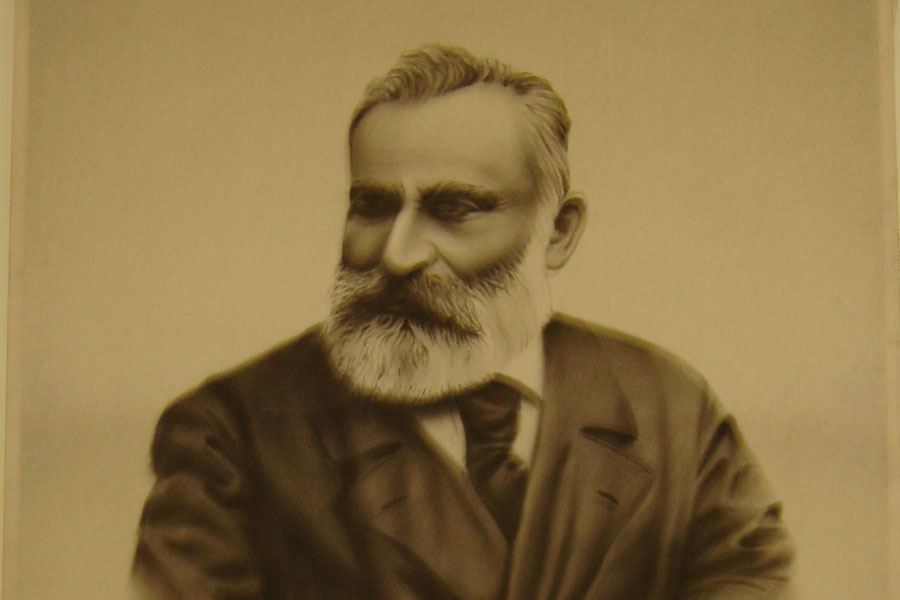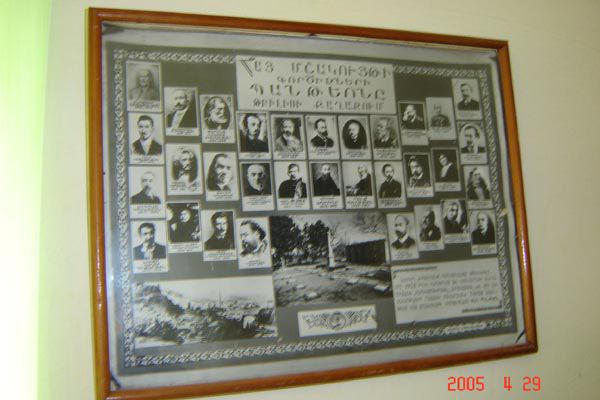
(© R. Bedevian/Groong)
Armenian News Network / Groong
May 23, 2004
Travel Wire
By Ruth Bedevian
ASHTARAK, ARMENIA
Greeted by the Director, Armida Ghambaryan, and resident docent, Evelina Ghornakchyan, my friend Gohar and I, were treated to a first class tour of the Perj Proshyan House Museum at 4 Proshyan Street in the delightful town of Ashtarak which extends itself on the banks of the Kasakh River 20 kilometers northwest of Yerevan. Ashtarak, which means `Tower' in Armenian, is the capital of the Aragatsotn Province and has spawned many Armenian luminaries , including, among others, Gevorg Emin, Smpat Shahaziz and the beloved Catholicos Nersess Ashtaraketsi [Nersess V (of Ashtarak) 1843-1857].
Perj Proshyan((1837-1907), made valuable contributions as an educator, novelist and translator. He also supported Armenian theater. A native of Ashtarak, he lived and worked most of his adult life in Tbilisi, Georgia, one of two centers of Armenian cultural life in the 19th century (the other being Constantinople). The proud people of Ashtarak rightfully claim him as their native son. Proshyan's birthplace was preserved as a museum in 1937 on the occasion of the writer's 100th anniversary of birth. The Soviet government, however, did not implement the decision until 1948 when restoration of the original site was begun. Over a period of years it was enlarged until it has become an impressive two story edifice with a wide balcony which overlooks a picturesque courtyard where the lilac trees were in full bloom on the day of our April 2005 visit.

|
|
Perj Proshyan (© R. Bedevian/Groong) |
We spent a good amount of time examining displays and artifacts, the bulk of which came as a donation from six of the writer's children. Today this museum operates as a branch of the Yeghishe Charentz Literature and Art Museum. We learned from our guides that Proshyan descended from a princely family who were landowners in Garni. Evidence of this was displayed in a family tree dating from the 15th century. There also was a photo of the family's coat of arms - the same coat of arms that can be seen on the church at Gerhard. Proshyan's grandfather was a priest in Oshagan. His name was Der Arakel Danilyan. `If one visits Oshagan one can find his grandfather's grave where it is written that he died in 1827,' claimed Evelina Ghornakchyan.

|
|
Nersessian Alumni Poster (© R. Bedevian/Groong) |
The Armenian bourgeoisie in Transcaucasia - Tiflis and Baku- had great wealth because of the discovery of the oil in Baku. This fact coupled with the ensuing industrialization of railroads and telegraph threatened the traditional society in which Armenians were living, particularly the Armenian peasantry. Proshyan examined the socio-political issues of the day through his novels. In the mid to late 1800s, Armenians perceived Russia as a friend, pinning hopes on Russia's support for Armenians to be freed from Ottoman domination, but following the Russian-Turkish War of 1876-1878, Russia set upon a policy of Russification and colonization, stifling Armenian intellectual activity. In this climate, writers, including Proshyan, made an effort to preserve Armenian history and protect Armenian values through literature. Among his contemporaries whom he valiantly joined in this effort were Raphael Patkanian, Gabriel Sundukyan, Raffi and Ghazaros Aghayian.
One of the longest running plays in the Sundukyan Theater was based on another novel entitled Hatsee Khundeer (A Matter of Bread). Professor Kevork B. Bardakjian in his monumental work "A Reference Guide to Modern Armenian Literature, 1500-1920," [Detroit, Michigan, Wayne State University Press, 2000- page 144] considers this novel Proshyan's masterpiece. `The novel, qualified as realistic, documents the destruction of traditional lifestyle and changing economic and social values in rural areas due to the penetration of monetary relations and mores. The novel is head and shoulders above all else Proshyan wrote; it reads well and has enriched Armenian literature with a few memorable characters (notably Mikitan Sak'o). Similar in theme and structure and almost as good was his fourth novel. Tsetser [tsets=moth, i.e. `parasites').'Among some short stories, there are a few other novels worthy of mention here - Shahen, (a novel about the Russian Persian War), Bghde, and Hoosher, his memoirs.
Armida Ghambaryan interjected with very interesting particulars that brought Proshyan to life, `He translated the Gospel of St. Matthew in 1882 from Grapar (Classical Armenian) to Ashkarhapar (Modern Armenian). He translated from Russian into Armenian the works of Tolstoy and Gogol. He opened many schools in Nakhijevan, Sushi, Yerevan and here in his hometown of Ashtarak. The school in Ashtarak is named after St. Nersess Ashtaraketsi and recently celebrated its 130th anniversary. It is two or three years older than the present Gevorgian Seminary [named after Catholicos Gevorg IV of Constantinople (1866-1882)]. In 1869 Proshyan married Anna Dolgyan, 16 years his junior. She was a descendant of Sayat Nova on her mother's side. They had three girls and three boys. Proshyan was a very faithful husband and devoted father. In 1905 Anna died. Not willing or able to live by himself, Proshyan went to Baku to live with his daughter and in 1907 he died. His remains were sent to Tiflis where he was buried in the Khojivank Pantheon of Armenian Writers cemetery amidst other illustrious contemporaries.'
We toured thoroughly the remaining floors of memorabilia, savoring the ambiance of the rooms filled with the furniture and belongings that were brought back from his Tbilisi home, including a baby grand piano. A room filled with theatrical posters and memorabilia emphasized his dedication to Armenian theater which he helped to found in Tbilisi. A poignant section on Proshyan's son, Prosh, saddened me. Prosh, a social revolutionary, was a member of the Law Faculty in Odessa University and took part in 1905 in assailing the prison to release political prisoners. He was sent to Siberia for ten years. He took part in the October Revolution. [`In 1917 Russia went through two revolutions: February 24-29 and October 24-25. The first revolution overthrew the Tsarist government and replaced it with a Provisional Government of Duma. On October 24-25 the Bolshevik party led Russian workers and peasants to revolution, under the slogan: `All Power to the Soviets.' On October 25-26, the Second All-Russian Congress of Soviets met and created the Soviet Government.' http://www.marxists.org/history/ussr/revolution/ ] Prosh became the Minister of Telegraph and Postal Service under Lenin in the new Soviet government. He, however, quarreled with Lenin over granting Armenian land to Turkey and fell out of favor.
After leaving the museum, we strolled across the courtyard to briefly view the restored birthplace, reminiscent of the rudimentary beginnings of Tumanyan's home in Dsegh and Abovyan's home in the Kanaker section of Yerevan. Before we attempted to depart, we were hospitably urged to taste the local fruits and homemade bastegh along with a cup of Armenian coffee. Indeed the local fruit is tasty. In a gesture of abundant kindness, Armida Ghambaryan snipped plentiful lilacs from Perj Proshyan's garden and presented them to us as a parting gift.
Indeed the afternoon tour of this engaging house museum completed a memorable day for this visitor from America! Had time allowed, a ride through the streets of the town would have been wonderful for truly Ashtarak possesses a pleasant and cheerful face.
-- Ruth Bedevian continues her visits to Armenian authors' House Museums around Armenia. Her articles in this series are at: http://www.groong.org/orig/armeniahousemuseums.html
|
Redistribution of Groong articles, such as this one, to any other
media, including but not limited to other mailing lists and Usenet
bulletin boards, is strictly prohibited without prior written
consent from Groong's Administrator. © Copyright 2005 Armenian News Network/Groong. All Rights Reserved. |
|---|